It’s that time of year once again. NHL free agency begins July 13, 2022 this year, as we see a slow but steady return to the season/offseason structure that COVID impacted. As some of you know, we here at Evolving Hockey provide numerous tools for evaluation in the offseason. In a way, almost everything on the site can be used to evaluate players during the summer. More specifically, we released both our contract projections and GAR projections for the coming summer/season in the past few months. These are available for Pro subscribers here:
Last offseason, I spent quite a bit of time on our two Seattle Expansion articles (here and here), which used our GAR projections in combination with projected rosters for a sort of mock draft experiment. But this year, I thought it would be interesting to use both projection systems in tandem to evaluate free agency ahead of its onset. For this, we return to our roots and go back to baseball.
Disclaimer: The following is something we’ve been meaning to write up for a while but haven’t found the time to do so. The next section(s) cover the ways in which we’re combining both contract and player projections for value assessment. This isn’t necessarily required to keep reading, but you may be a little confused by the tables below if you skip it.
Cost Per Win
While this isn’t new to us at EH (our player pages have metrics that cover value in a similar way), I’m going to be using this in a different way than the player pages do. One of the first things we ever did was research “cost per win” type methods developed for baseball evaluation years ago and how they could be applied to hockey. It’s been a long time since we’ve really covered this, and realistically an entire article should be devoted to this, so I’ll summarize the general idea for the purpose of this article.
There is a long and rich history in the Sabermetrics community behind the calculation of how much a “win” “costs”. Any given team in any given sport is, theoretically, attempting to buy wins when acquiring players in free agency. Teams sign players during the summer that they hope will have a positive impact on their overall record (add wins to that record). Pairing contract data and WAR values in baseball, analysts have attempted to calculate how much a marginal win “costs” each year. Put in question form: how much must a team spend to acquire 1 win? This is often referred to as “Cost per Win”, “$ / Win”, or simply “Dollars”.
The history in baseball is deep here – I’m not going to cover this in as much detail as it requires. Please reference these articles for much more information:
- https://blogs.fangraphs.com/win-values-explained-part-six/
- https://blogs.fangraphs.com/the-cost-of-a-win-in-free-agency-in-2020/
- https://tht.fangraphs.com/methodology-and-calculations-of-dollars-per-war/
- https://www.beyondtheboxscore.com/2013/10/15/4818740/how-much-does-a-win-really-cost
In hockey, we can do the same thing baseball analysts have done using our own WAR model, contract data, and the methods baseball analysts developed in the past. For our purpose, we will use this version but with Goals Above Replacement (GAR). GAR is essentially the same thing as WAR, but unscaled for the season-environment (for modern hockey, GAR and WAR/SPAR are extremely similar). The calculation is exactly the same, it just results in a different value and looks like this (calculated separately for forwards and defensemen):
1. Goal Value = sum(cap hit) / sum(weighted average [6/3/1] of prior 3-season GAR preceding a signed contract)
2. Goal Value Rolling = 2-year rolling average of Goal Value
3. Cost per Goal = (GAR * Goal Value Rolling) – League Minimum Salary
With concision in mind, what the above does is calculate a 2-year rolling value for each position based on each player’s previous performance (weighted average of prior 3-season GAR) and their next contract. We take a 2-year rolling value here due to the changing salary cap structure historically in the NHL, which allows us to smooth out spikes season over season. The first two steps arrive at a dollar value for what 1 Goal Above Replacement is worth for each position. The last step calculates each player’s Cost per Goal value: multiply GAR by the rolling goal value by position and subtract the league minimum salary. The league minimum salary is subtracted to account for replacement level.
On average, it costs ~$820k to buy one Goal Above Replacement for forwards and ~$961k to buy one Goal Above Replacement for defensemen currently. A little more on that below. Going back to 2007, player values in-season range from around -$14M up to about $24M. We’ll have more on this in a future article!
Here’s a quick overview of what Cost per Goal values usually look like in the NHL:
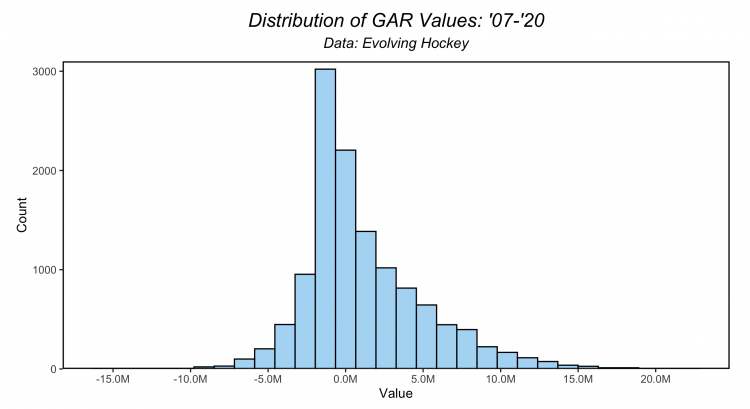
There is also a fairly large difference between the value of a goal for forwards and defensemen. This reflects the difference in GAR distributions for forwards and defensemen. On average, forwards tend to be more valuable from a GAR perspective than defensemen. Because of this, it costs “more” to acquire goals from defensemen than it does for forwards (and vice versa). This gap isn’t that much bigger, but it does show up when assessing value-added for defensemen. Forwards tend to contribute more on offense than defensemen do, and even-strength offense within the environment accounts for a larger portion of total GAR than the other components. This doesn’t mean defensemen are less valuable, it means that it’s easier to find “cheaper” forwards because they are often in a position to add more value overall and/or twice as many forwards play in a hockey game as defensemen.
Calculating Expected Free Agent Value
For this article, I’m using both our contract projections and GAR projections to evaluate who the best (and worst) value available skaters are in the 2022 NHL offseason. We don’t currently have a model to project goalie GAR for future seasons, so unfortunately goalies are left out here.
An issue that becomes obvious quite quickly here is that in-season GAR totals and projected GAR totals are not the same. The distribution looks similar, but the min/max for projected GAR is much lower than the actual totals we see in a given season. Within a full season, GAR values tend to range from -14 to 30, with a lot of wiggle room. Our projections tend to range from -3 to 20 give or take. Because of this, the cost per goal values we’ll be using are not entirely comparable to what we can expect in a given season. We’ve covered this in various other places before, but our GAR projections are the result of a model that accounts for uncertainty – almost all of which is due to the high variance in playing time season over season. That being said, I’ve used our uncertainty metrics (+ / – a given projection) to account for the ranges of potential performance.
Each section below contains two tables. The first shows the Cost per Goal values. I’ve used “CPG” to denote the GAR-determined value for each player along with the mentioned value ranges (Low, Estimated, and High). The “Estimated” column shows a given player’s value based on our projected GAR – this is the comparable number to our contract projections. I also included the most likely contract for each player (Pred Yrs and Pred Cap), and the “Difference” of our Estimated Cost Per Goal value minus our most likely projected contract. The second shows each player’s GAR projection breakdown for the upcoming season.
As a point of reference, here’s how our GAR projections compare to the contract projections right now for current free agents (both UFA and RFA). The two lines represent our current cost per goal values covered above. Formatting is done by position. While we do see a correlation between both projections, there are some large outliers on both ends. I’ve highlighted a few of the players I’ll be discussing below.
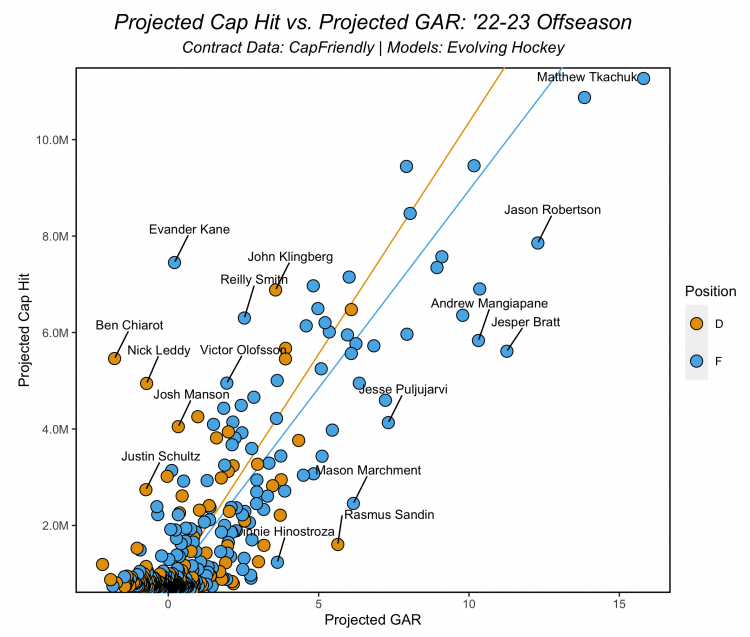
Best Value: UFAs
I’m going to look at the top 15 players based on our calculations for each section.
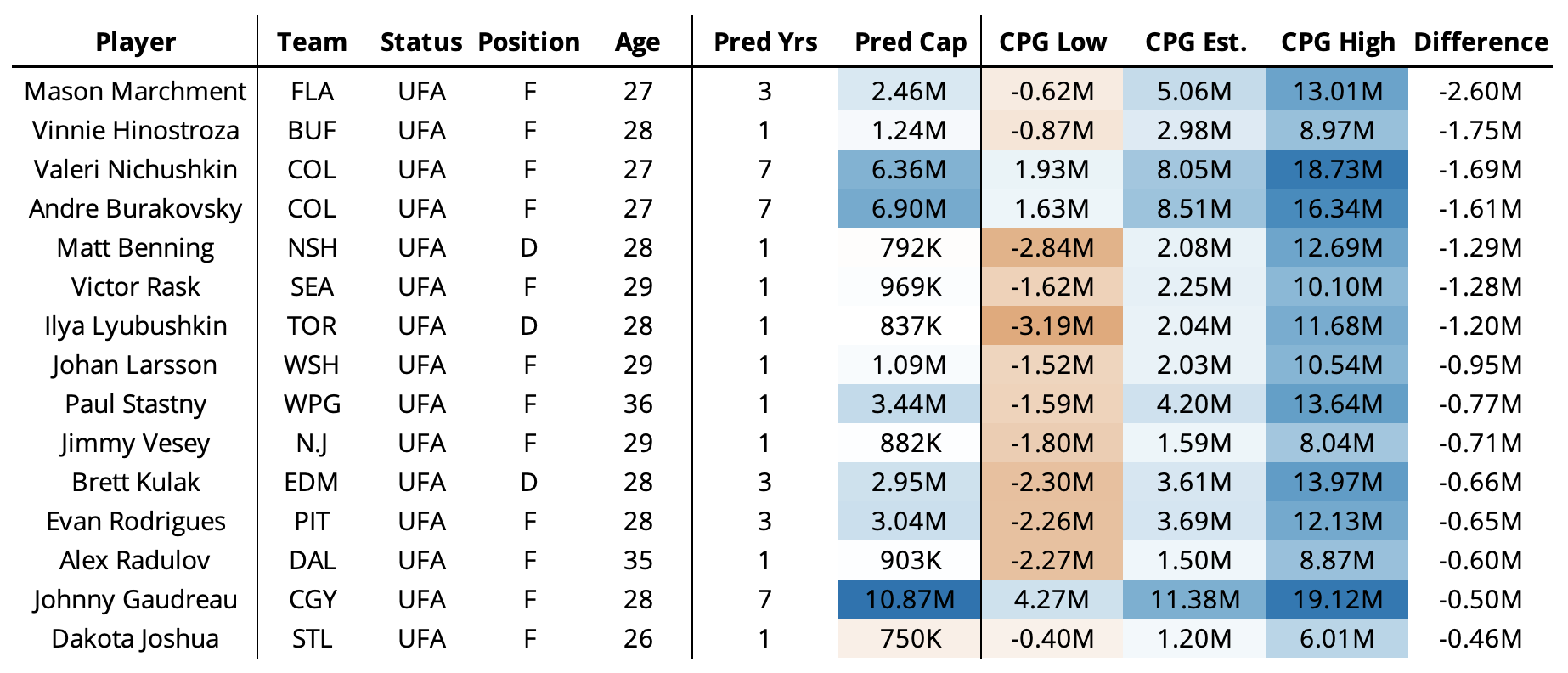

The UFA players fall into three categories:
- <$1M depth guys
- $2-4M solid middle-of-the-lineup players
- >$6M potential stars
Regardless of which group a player falls in, looking at all these players’ GAR components, only Burakovsky has below-0 projected EVD (even-strength defense); one of the driving forces behind these players’ value is there positive defensive play. Position and uncertainty should be kept in mind, but this trend holds true with what I found reviewing last offseason’s free agent signings as well.
Several of these players are likely controversial when considered as potential signings for teams. Victor Rask was traded by Minnesota to Seattle for future considerations and 50% retained salary, Mason Marchment exploded in Florida this season after playing only 33 games as 26 year old rookie, Hinostroza has bounced between 4 teams over the last 3 seasons playing low roles on every team, Paul Stastny is 36 years old with baggage, Jimmy Vesey is, well, Jimmy Vesey, etc. Several of these players have become household names among the hockey statistics community and go against the common narratives of most media: Nichushkin, Burakovsky, Kulak, Rodrigues, and Larsson among others.
All that said, and a lot of this relies on how much you trust our contract and GAR projections on Evolving Hockey (I’m sure you trust these 100% of course), all of these players would likely be solid to possibly incredible players for any team to add once free agency opens. There is some uncertainty baked in here with a few players (specifically for Nichushkin and Burakovsky for those who think they benefited from playing on a stacked Colorado team that models can’t capture). Regardless, it seems these players are set to be some of the most valuable additions for any team in the coming months during this offseason.
At our projected contract for Mason Marchment, it seems like a no-brainer for any team to “take a chance” on him. I’m of the opinion that he will likely sign for a decent amount more than what our projections have him at, but there is a lot of uncertainty surrounding the 27-year-old undrafted winger who played most his first NHL games the season before last. I mean just look at his RAPM chart for this past season:

The Colorado players here, for my money, are possibly the best additions for a team looking to stay under ~$7M per year for a borderline elite player. Nichushkin is well-known in the community as a stats all-star, but Burakovsky has gone a little under-the-radar and has been consistently stellar offensively. Recent rumors suggest Nichushkin may be returning to Colorado next season, but even at a shorter term deal, Burakovsky has a ton to offer for a team looking for a consistently fantastic offensive winger.
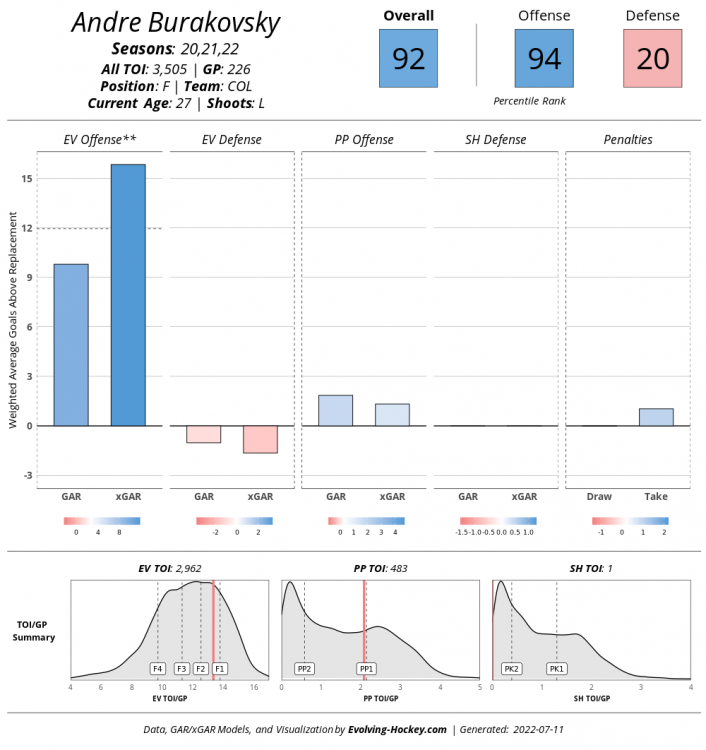
Only two players in this group are over the age of 30. It appears Radulov is returning to Russia to play in the KHL next season (I didn’t realize this until I finalized the tables, so I apologize). Paul Stastny is the lone 30+ UFA with potential value by our models. With Winnipeg, he put up some surprisingly good numbers from our RAPM and GAR models all things considered and could be a solid depth player for a team willing to sign him.
Lastly, I’d be remiss if I didn’t mention Evan Rodrigues. Like Marchment, Rodrigues came out of nowhere this past season. In a different way. Buffalo fans will remember his effective defensive play 3-5 years ago, and he has 7 seasons of experience at this point, but few thought he’d do what he did this year with Pittsburgh. At 3 years x $3M, he might be one of the biggest bargains available come July 13th.
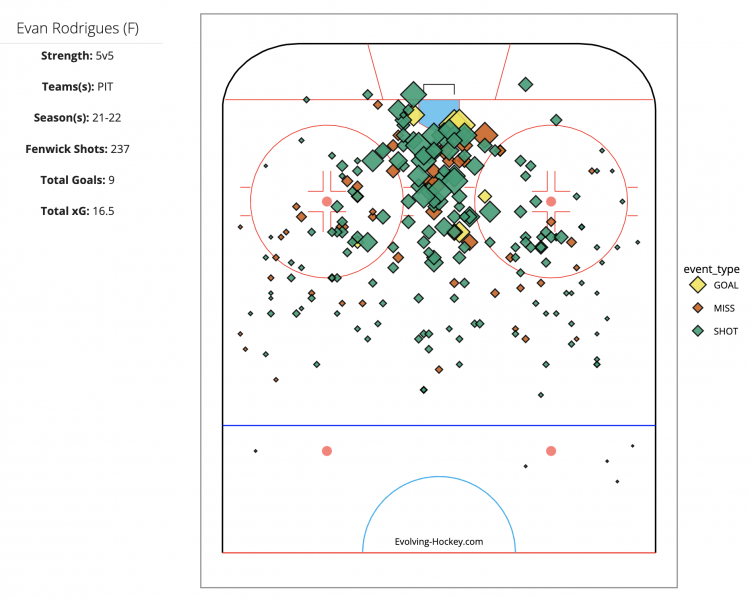
Best Value: RFAs
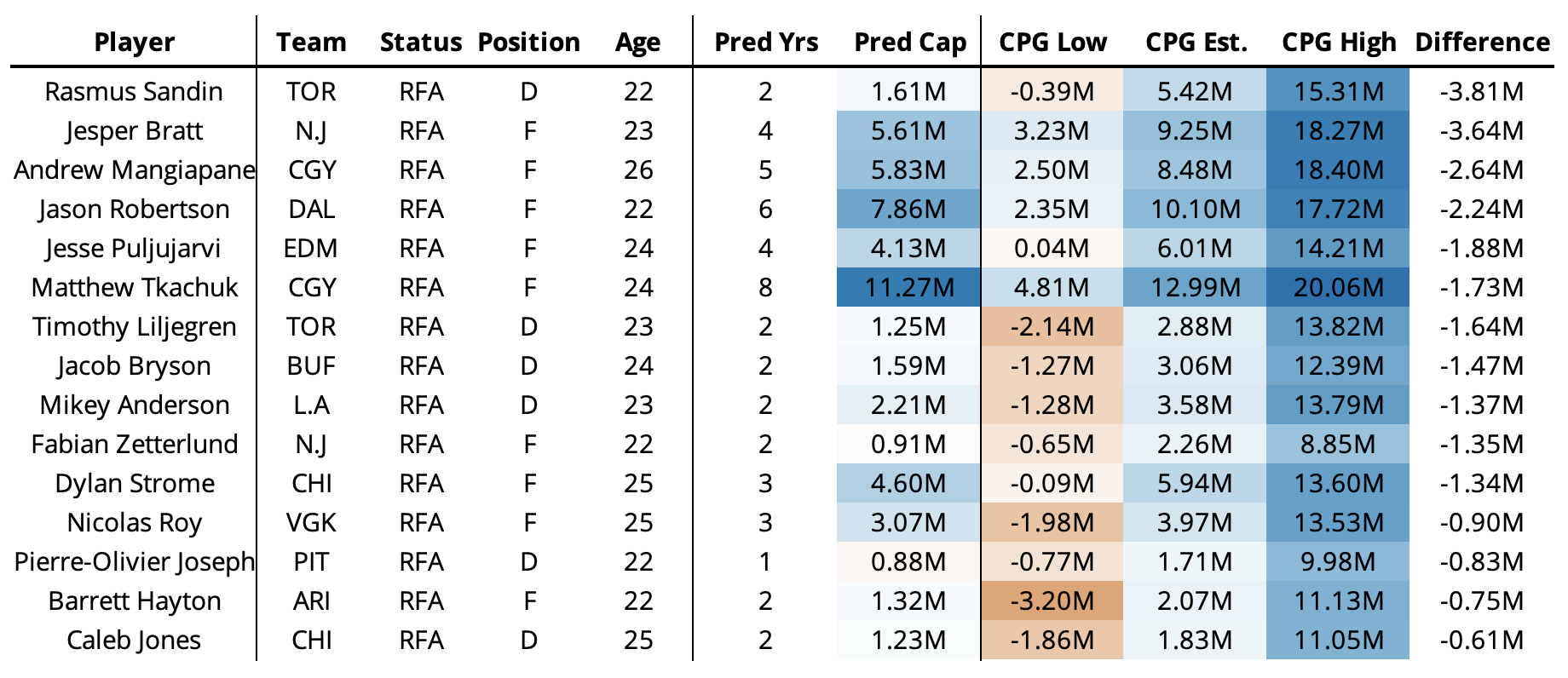
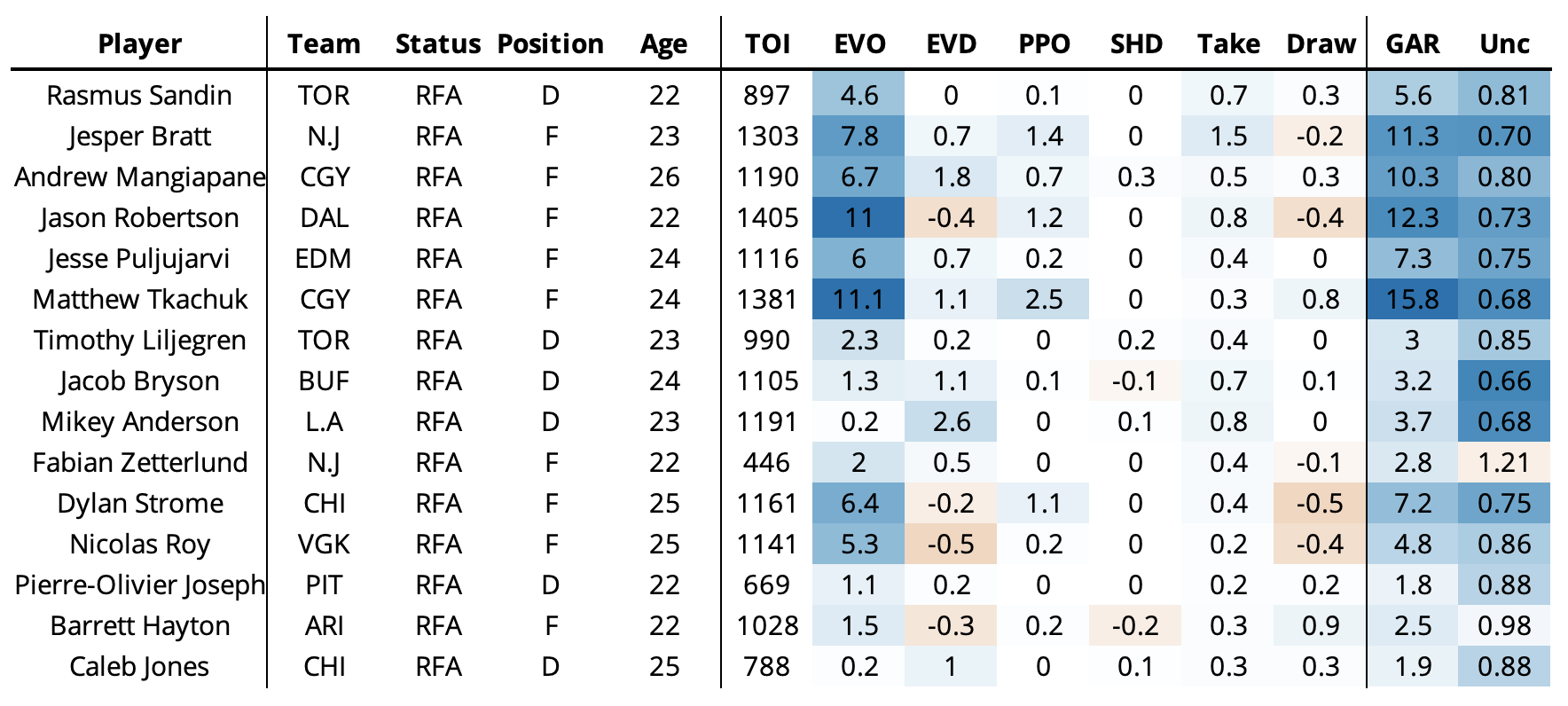
RFAs are obviously different than UFAs, but it’s interesting to look at which teams have the best young free agents under control. Or, which teams will screw it up. It seems more than likely that most of these players will be returning to their “current” teams given trading RFA rights is fairly rare, not qualifying (especially good) players is even more rare, and offer sheets don’t exist. That said, at least two of the players listed will likely not be returning to their former teams. Things get spicy.
Rasmus Sandin, Jesper Bratt, and Andrew Mangiapane grade out as the most valuable free agents of any skaters (including UFAs) this free agency season. I hate having a Leafs player #1 here, and a lot of this is due to our low projected bridge deal for Sandin, but he is a very good young defenseman with room to grow. High-upside offensive defensemen, or at least those with high EVO in our GAR model, are specifically high-variance. However, Sandin’s results have been phenomenal the last three seasons (not just his on-ice goals). Even if the Leafs extend him for 8 years, he’d still likely be more valuable than our current 8-year projection of $3.6M per year.
Jesper Bratt is another fantastic young player who posted some spectacular numbers last season. Recent news suggests the Devils are possibly close to re-signing him, and while we have his projected contract at 4 years, more in-line with high-level RFAs bringing him to UFA sooner, a longer-term deal makes a lot of sense if Bratt is willing to sign one. We may have missed on Jersey last season with our point projections, but maybe we were just a year early.
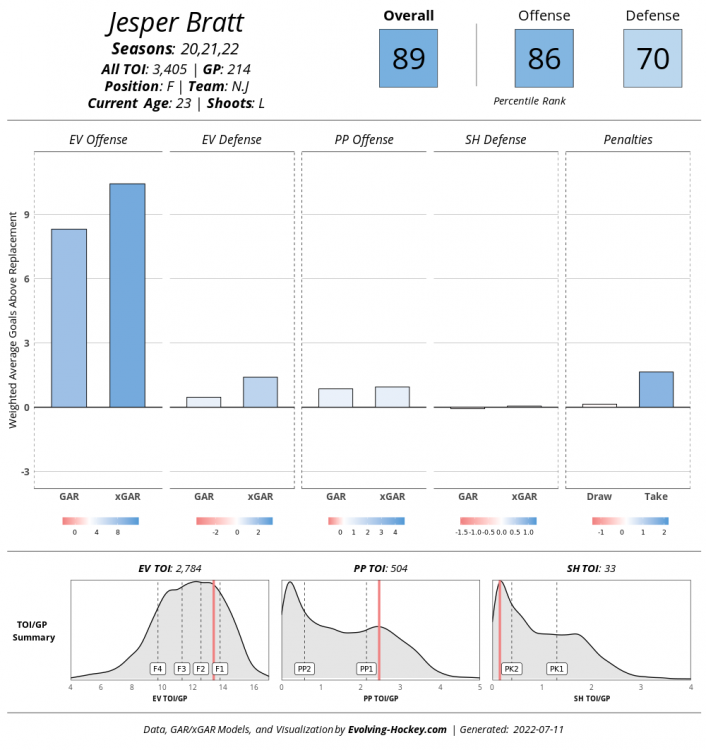
Andrew Mangiapane just adds to the Flames potential issues with their numerous high-level free agents (although they currently have nearly $27M in projected cap space per Cap Friendly). Mangiapane is all-upside: no obvious weaknesses, one of the best defensive free agent forwards in his class, and a modest expected deal given his value. All eyes are on Gaudreau and Tkachuk, but getting Mangiapane’s deal done shouldn’t be overlooked.
Let’s talk about Jason Robertson. Hey Stars: sign him to as much money as he wants.
Jesse Puljujärvi is easily the most interesting free agent (who shouldn’t be on the market). Everyone other than the fans (ok probably some of the fans) have more or less run Pool out of town, and the latest reports indicate the Oilers are not only actively shopping his rights, but that they’re disappointed that no teams seem to be interested. It’s likely that his “high” amount of “time on ice” with McDavid last season (65% at even-strength) is the reason for this, but smart teams should be trying to get him for as little as possible. Yesterday, the Oilers issued him a qualifying offer, so it appears there may be hope for Puljujärvi Oilers fans.
Matthew Tkachuk is really really really good. The Flames probably couldn’t overpay him if they tried. I mean, look at this:
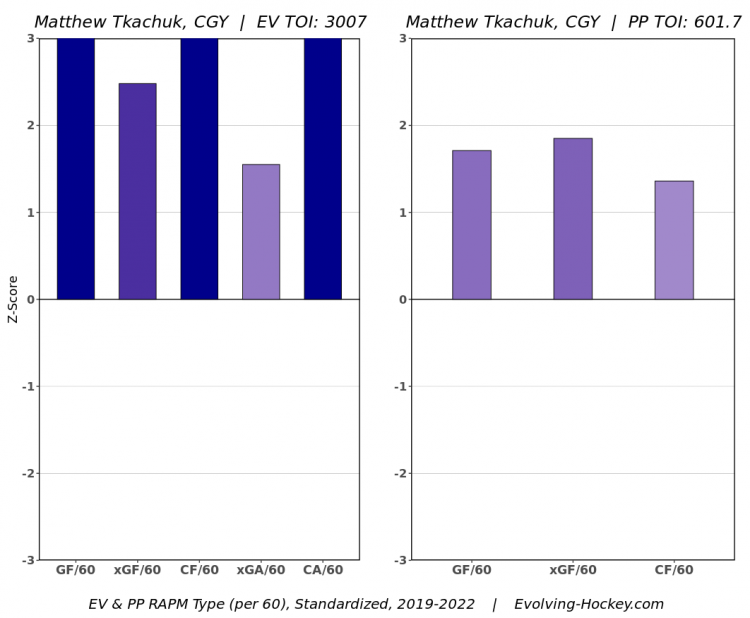
A few tidbits: Jacob Bryson signed a deal right in line with our projection, which is great for Buffalo. Chicago did not extend Dylan Strome a qualifying offer, so he’s actually not an RFA anymore. I’m already at 3000 words here, so I don’t have the time or space to get into Chicago’s ongoing offseason, but it’s definitely an offseason. Several of the remaining players are low-cost young assets that seem like absolute steals, disregarding any controversy regarding whether they should be bridged or not. I have also never heard of maybe three of these players, which is usually a good sign historically.
Again, we see a trend with high-EVD values among this group of RFAs. It’s not easy to identify defensive play from players, and it’s even harder to predict it, but one of the best ways to become/stay competitive as an NHL team is to find players who are undervalued. We’ve been talking about this for as long as I’ve been a hockey fan: skater defense matters. Thanks for coming to my TED talk.
Worst Value: All Free Agents
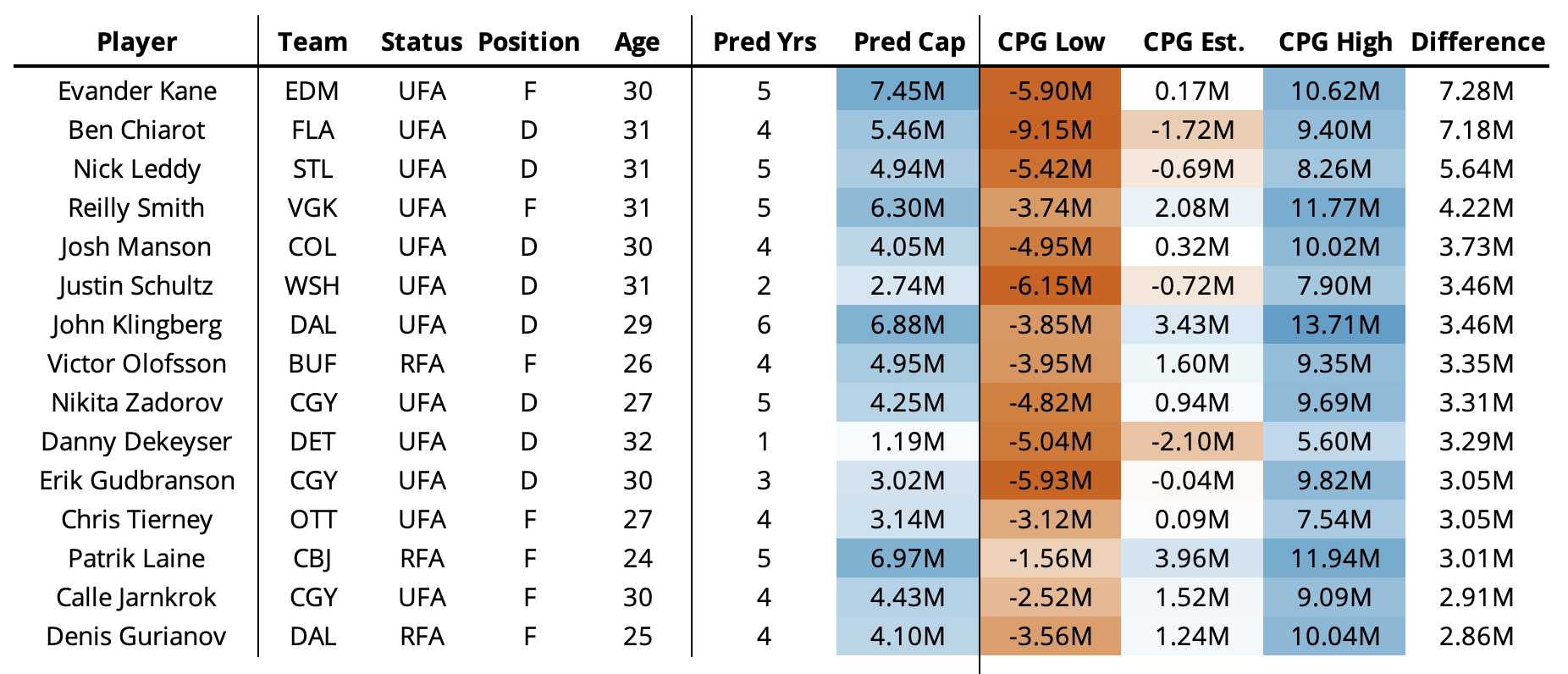

It wouldn’t really be a Free Agency preview without a quick look at the potential worst value players in the league. I’m not going to go into as much detail here as I did above but glancing over a lot of these players confirms one thing: signing 30+ UFAs to long-term high-value deals is almost never a good idea. Even still, a few of these players in this group are just that bad even without a long term deal. Again, a lot of this relies on our projections, but given how low the uncertainty values are for numerous players above, it shouldn’t be that contentious.
There isn’t much to say outside of the obvious: modern successful NHL teams tend not to sign the kind of contracts listed above for these kinds of skaters. It’s almost guaranteed any team can find someone who does something similar on the ice to whatever anyone above does and pay a fraction of what these players will likely command.
Now, there are some caveats here. Our contract model doesn’t consider “available” players within a given offseason’s market. For instance: good defensemen are especially scarce it seems in 2022. Kris Letang, Mark Giordano, Tony DeAngelo, and Adam Boqvist have already signed contracts, which leaves a surprising lack of potential high-point-total defensemen available (even with a few of these being RFAs). Several teams will almost certainly overpay a few defensemen this offseason to fill spots, which, let’s be honest, is a tradition as old as the NHL. But my advice to most teams remains consistent: you probably have someone in your system that can do whatever one of these aging defensemen can for much cheaper than they will cost. They may even be better if you give them a chance.
Wrapping Up
As always, we’ll be tracking how both of our projection models do in the coming months. There really is no other time like the first few weeks of free agency, and we’ve already seen some major changes to several teams before July 13th. I’m terrible at scheduling things, but I’ll likely have an early Free Agency evaluation article up in mid-August. Let me know what you think in the comments below. I’d love to hear your feedback!
Best of luck to your favorite team. I hope all the players get all the money and your favorite team wins.
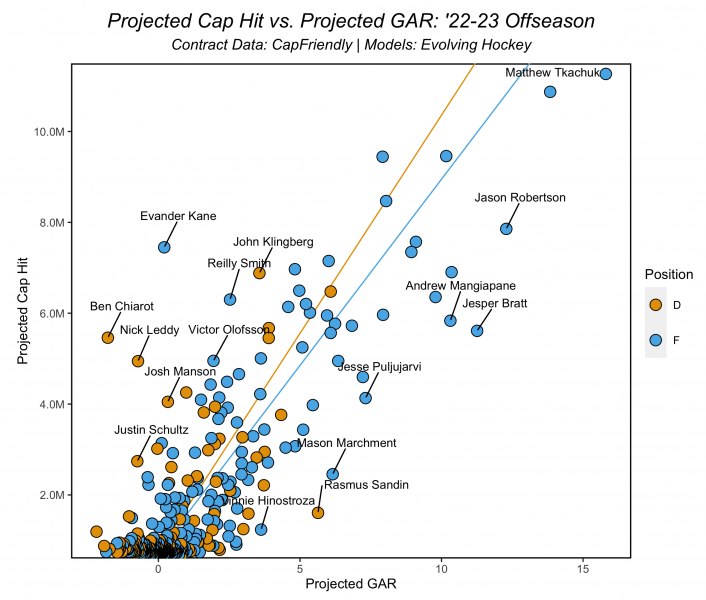
Your formulas look super janky.
Pretty sure the numerator for Goal Value should be summing the excess of cap hit over league minimum, not just cap hit.
And your CPG should be adding League Minimum Value, not subtracting.
And that’s setting aside that “cost per goal” would be a much better descriptor of the thing you’re calling Goal Value than it is of the thing you’re calling Cost per Goal. The thing you’re calling CPG would be better termed Goal-Equivalent Value.
Last, why use GAR for this? Why not get Goal Value by simply summing cap hits and dividing by sum of goals? And calculate the thing you’re calling CPG by multiplying Goal Value by expected goals?